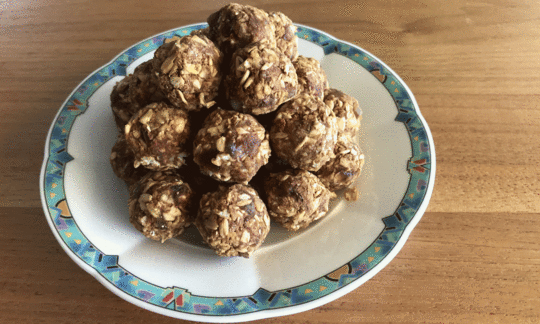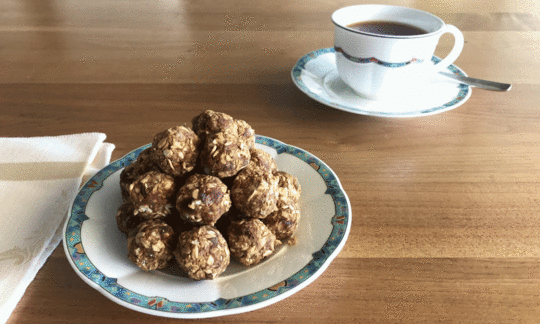Oat dessert balls made from pomace (e.g. carrots)
vegan
Ingredients (for servings, )
| 3 ½ oz | Carrots (carrots), raw (organic?) |
| 7 ⅓ oz | Oat flakes (raw?, organic?) |
| 1 tbsp | Ginger, raw (organic?) (0.30 oz) |
| 1 tbsp | Lemon juice (raw?, organic?) (0.26 oz) |
| ½ tbsp | Cocoa powder, unsweetened (raw?, organic?) (0.09 oz) |
| 1 ¾ oz | Dates, variety Deglet Nour, pitted, raw?, (organic?) |
Equipment
- juicer
- grater
- citrus juicer (lemon squeezer)
Type of preparation
- chop or grind
- food preparation without heating
- juice
- squeeze
- peel
- grate (shred)
Preparation
For the carrot pulp (if not available)
Juice the carrots using a juicer or food processor and use the pulp.If you have a carrot tester, you can skip this step.
Since we assume that you will consume the carrot juice as a drink or in some other way, the ingredients of the whole carrots are included in this recipe.
Preparation of the oat dessert balls
Peel the ginger and grate it finely. Chop the dates into fine pieces with a knife. Place the chopped ginger, dates and the remaining ingredients in a suitable bowl.You can also chop the dates with a hand blender.
We use whole oats, which we grind in a grain mill. If you use sproutable (and therefore raw) seed oats or naked oats, then this recipe can also be prepared as a raw food. The oats or oat flakes that are usually available commercially are usually dried and therefore not raw.
Mix the entire dessert ball mixture well so that the dates are evenly distributed. Then form small balls with your hands and store in the fridge until ready to eat.
Try it out: Before forming the dessert balls, taste the mixture and refine it with other ingredients if necessary. Experiment with the mixture a little, for example, if the balls stick together better by increasing the amount of dates. If they are too moist, you can increase the amount of oat flakes, etc.
Shelf life: The oat dessert balls will last for at least 3-4 days in the refrigerator.
|
Nutritional Information per person
Convert per 100g
|
2000 kcal | |
|---|---|---|
| Energy | 191 kcal | 9.5% |
| Fat/Lipids | 2.8 g | 4.0% |
| Saturated Fats | 0.50 g | 2.5% |
| Carbohydrates (inc.dietary fiber) | 37 g | 13.8% |
| Sugars | 7.8 g | 8.6% |
| Fiber | 5.6 g | 22.6% |
| Protein/Albumin | 5.8 g | 11.7% |
| Cooking Salt (Na:16.7 mg) | 43 mg | 1.8% |
| Essential micronutrients with the highest proportions | per person | 2000 kcal | |
|---|---|---|---|
| Min | Manganese, Mn | 1.5 mg | 77.0% |
| Prot | Tryptophan (Trp, W) | 0.08 g | 31.0% |
| Elem | Phosphorus, P | 182 mg | 26.0% |
| Min | Selenium, Se | 12 µg | 22.0% |
| Prot | Threonine (Thr, T, irreversibly transaminated) | 0.20 g | 22.0% |
| Min | Copper, Cu | 0.21 mg | 21.0% |
| Vit | Vitamin A, as RAE | 167 µg | 21.0% |
| Vit | Vitamin B1 (Thiamine) | 0.20 mg | 19.0% |
| Prot | Phenylalanine (Phe, F) | 0.29 g | 19.0% |
| Prot | Valin (Val, V) | 0.30 g | 19.0% |
Detailed Nutritional Information per Person for this Recipe
The majority of the nutritional information comes from the USDA (US Department of Agriculture). This means that the information for natural products is often incomplete or only given within broader categories, whereas in most cases products made from these have more complete information displayed.
If we take flaxseed, for example, the important essential amino acid ALA (omega-3) is only included in an overarching category whereas for flaxseed oil ALA is listed specifically. In time, we will be able to change this, but it will require a lot of work. An “i” appears behind ingredients that have been adjusted and an explanation appears when you hover over this symbol.
For Erb Muesli, the original calculations resulted in 48 % of the daily requirement of ALA — but with the correction, we see that the muesli actually covers >100 % of the necessary recommendation for the omega-3 fatty acid ALA. Our goal is to eventually be able to compare the nutritional value of our recipes with those that are used in conventional western lifestyles.
| Essential fatty acids | per person | 2000 kcal |
|---|---|---|
| Linoleic acid; LA; 18:2 omega-6 | 0.91 g | 9.0% |
| Alpha-Linolenic acid; ALA; 18:3 omega-3 | 0.04 g | 2.0% |
| Essential amino acids | per person | 2000 kcal |
|---|---|---|
| Tryptophan (Trp, W) | 0.08 g | 31.0% |
| Threonine (Thr, T, irreversibly transaminated) | 0.20 g | 22.0% |
| Phenylalanine (Phe, F) | 0.29 g | 19.0% |
| Valin (Val, V) | 0.30 g | 19.0% |
| Isoleucine (Ile, I) | 0.23 g | 18.0% |
| Leucine (Leu, L) | 0.43 g | 18.0% |
| Lysine (Lys, K, irreversibly transaminated) | 0.29 g | 15.0% |
| Methionine (Met, M) | 0.09 g | 10.0% |
| Vitamins | per person | 2000 kcal |
|---|---|---|
| Vitamin A, as RAE | 167 µg | 21.0% |
| Vitamin B1 (Thiamine) | 0.20 mg | 19.0% |
| Vitamin B7 (Biotin, ex vitamin H) | 9.0 µg | 18.0% |
| Vitamin B9, B11 (Folate, as the active form of folic acid) | 19 µg | 10.0% |
| Vitamin B5 (Pantothenic acid) | 0.57 mg | 9.0% |
| Vitamin B2 (Riboflavin) | 0.08 mg | 6.0% |
| Vitamin B6 (pyridoxine) | 0.09 mg | 6.0% |
| Vitamin B3 (Niacin) | 0.80 mg | 5.0% |
| Vitamin K | 3.7 µg | 5.0% |
| Vitamin E, as a-TEs | 0.31 mg | 3.0% |
| Vitamin C (ascorbic acid) | 1.9 mg | 2.0% |
| Essential macroelements (macronutrients) | per person | 2000 kcal |
|---|---|---|
| Phosphorus, P | 182 mg | 26.0% |
| Magnesium, Mg | 65 mg | 17.0% |
| Potassium, K | 291 mg | 15.0% |
| Calcium, Ca | 32 mg | 4.0% |
| Sodium, Na | 17 mg | 2.0% |
| Essential trace elements (micronutrients) | per person | 2000 kcal |
|---|---|---|
| Manganese, Mn | 1.5 mg | 77.0% |
| Selenium, Se | 12 µg | 22.0% |
| Copper, Cu | 0.21 mg | 21.0% |
| Zinc, Zn | 1.6 mg | 16.0% |
| Iron, Fe | 1.9 mg | 14.0% |
| Iod, I (Jod, J) | 1.0 µg | 1.0% |
| Fluorine, F | 0.64 µg | < 0.1% |
This recipe allows the use of press residues, e.g. carrot pulp, for the preparation of oat-based dessert balls.
Portion size and shelf life: We have set the portion size at 5. Decide for yourself how many of these treats you think are appropriate. The oat dessert balls will last for at least 3-4 days in the refrigerator.
Oatmeal and "cooked food"? We have labeled this recipe as "cooked food" due to the oat content, as conventional oat flakes are no longer strictly speaking "raw food" as a result of heat and steam treatment. For a raw food version, you can use oat flakes made from pre-germinated oats. The germination process used here makes the oat flakes more digestible and at the same time increases the bioavailability of their valuable ingredients.
Availability bottlenecks: We tried to get germinating (and therefore raw) seed oats or naked oats. However, at the time of our inquiries (July 2019), there were also delivery bottlenecks or no deliveries at major suppliers in Switzerland and Germany!
Nutrient profile (including carrot juice): Since we assume that you will consume the carrot juice as a drink or in some other way, the ingredients of the whole carrots are included in this recipe. According to GDA guidelines, one portion therefore covers a good ¾ of the average daily requirement of manganese. In addition, one portion covers around ⅕ of the requirement of threonine, phosphorus, copper and selenium. You can find good advice on nutrition at the following link: Vegans often eat unhealthily. Avoidable nutritional errors.
Pomace: Pomace is the predominantly solid (press) residue that arises during certain ingredient processing processes, such as juicing fruit and vegetables.
Carrots and carotenes: Carrots are popular as a low-calorie raw food and are known above all for their high carotene content. Carotenes are fat-soluble, secondary plant substances. The best-known representative is so-called beta-carotene, which gives the carotene group its name and is also an important precursor in the body's own production of retinol (vitamin A). For this reason, it is also called pro-vitamin A.
Gluten-free : For those with gluten intolerance (celiac disease), only gliadin is intolerant, not glutenin. Those affected must therefore avoid classic grains such as wheat, but can eat oatmeal to a certain extent. In this case, however, it must not only be ensured that the oats are not contaminated with wheat and other gluten-containing grains, but they must also be specially cleaned. Corresponding oats are known as gluten-free oats. available in stores.
Refine the taste: For further refinement and experimentation with the taste, cinnamon, vanilla, lucuma powder or carob powder are suitable. Fruit can also be added, but this will make the mixture more moist, which means that the oat flakes have to be increased.
Raw food: If you use sproutable (and therefore raw) seed oats or naked oats, then this recipe can also be prepared raw.






